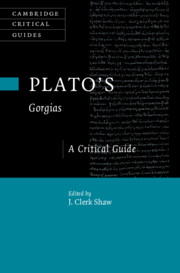Book contents
- Plato’s Gorgias
- Cambridge Critical Guides
- Plato’s Gorgias
- Copyright page
- Contents
- Contributors
- Abbreviations
- Introduction
- Chapter 1 Gorgias of Leontini and Plato’s Gorgias
- Chapter 2 Ancient Readers of the Gorgias
- Chapter 3 Philosophy and the Just Life in the Gorgias
- Chapter 4 Socrates and Coherent Desire (Gorgias 466a–468e)
- Chapter 5 The Ethical Function of the Gorgias’ Concluding Myth
- Chapter 6 Shame in the Gorgias
- Chapter 7 Desire and Argument in Plato’s Gorgias
- Chapter 8 Cooperation and the Search for Truth
- Chapter 9 Freedom, Pleonexia, and Persuasion in Plato’s Gorgias
- Chapter 10 Revealing Commitments
- Bibliography
- Index
- Cambridge Critical Guides
Chapter 6 - Shame in the Gorgias
Published online by Cambridge University Press: 25 May 2024
- Plato’s Gorgias
- Cambridge Critical Guides
- Plato’s Gorgias
- Copyright page
- Contents
- Contributors
- Abbreviations
- Introduction
- Chapter 1 Gorgias of Leontini and Plato’s Gorgias
- Chapter 2 Ancient Readers of the Gorgias
- Chapter 3 Philosophy and the Just Life in the Gorgias
- Chapter 4 Socrates and Coherent Desire (Gorgias 466a–468e)
- Chapter 5 The Ethical Function of the Gorgias’ Concluding Myth
- Chapter 6 Shame in the Gorgias
- Chapter 7 Desire and Argument in Plato’s Gorgias
- Chapter 8 Cooperation and the Search for Truth
- Chapter 9 Freedom, Pleonexia, and Persuasion in Plato’s Gorgias
- Chapter 10 Revealing Commitments
- Bibliography
- Index
- Cambridge Critical Guides
Summary
The feeling of shame (aischunē) is a dramatic key of the Gorgias, notably revealed by Callicles, who accuses both the master of rhetoric Gorgias and Polus of surrendering to Socrates’ refutation out of shame, before yielding himself to the feeling he declared himself immune to. But shame is not only a literary pattern in the dialogue: its function is closely connected to the kind of refutation of each interlocutor. It can be minimally said that shame is a natural effect of refutation, and optimally that it is an essential lever for Socrates to make his interlocutors acknowledge their deep moral commitments. This chapter aims at distinguishing several levels, rather than kinds, of shame among the interlocutors of the Gorgias: shame as sensitivity to others’ opinion, shame as an indication of the beliefs and values we are committed to, and shame as a potential step towards a better understanding of the real good. Though these levels sometimes overlap in the narrative, such distinctions may aid in understanding the role of shame for each interlocutor. Shame remains, for Plato, an ambiguous emotion, which must be used in a certain way to perform purification of wrong opinions.
- Type
- Chapter
- Information
- Plato's GorgiasA Critical Guide, pp. 105 - 123Publisher: Cambridge University PressPrint publication year: 2024

